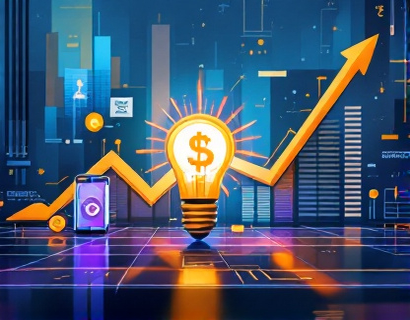Unlocking Strategic Growth: Leveraging Cutting-Edge Technology for Informed Decision-Making in Global Capital Markets
In the fast-paced and highly competitive world of global capital markets, the ability to make informed decisions swiftly and accurately is paramount. The integration of advanced technologies offers a transformative opportunity for financial analysts and decision-makers to unlock strategic growth. This article delves into the critical role of cutting-edge technology in enhancing the analysis and decision-making processes within global capital markets, providing actionable strategies and deep insights for professionals in the field.
The financial landscape is continuously evolving, driven by technological advancements, regulatory changes, and shifting market dynamics. To thrive in this environment, it is essential to harness the power of innovative tools and platforms that can process vast amounts of data, provide real-time insights, and support predictive analytics. By leveraging these technologies, organizations can gain a competitive edge, optimize operations, and drive sustainable growth.
Enhancing Data Analysis with Advanced Technologies
One of the most significant impacts of technology on global capital markets is the enhancement of data analysis capabilities. Traditional methods of data collection and analysis are often time-consuming and prone to human error. Advanced technologies such as artificial intelligence (AI), machine learning, and big data analytics have revolutionized the way financial data is processed and interpreted.
AI and machine learning algorithms can analyze large datasets with unprecedented speed and accuracy, identifying patterns and trends that may not be visible to human analysts. These technologies can process structured and unstructured data from various sources, including financial statements, market news, social media, and economic indicators. By automating the data analysis process, financial professionals can focus on higher-level strategic tasks, such as interpreting results and making informed decisions.
Big data analytics further amplifies these capabilities by enabling the handling of massive volumes of data. This allows for a more comprehensive view of market conditions, consumer behavior, and economic trends. For instance, by analyzing historical market data alongside real-time news feeds and social media sentiment, analysts can gain a deeper understanding of market dynamics and potential risks.
Real-Time Market Monitoring and Alert Systems
Real-time market monitoring is another critical area where technology has made significant strides. Traditional market monitoring tools often rely on delayed data feeds, which can result in missed opportunities or delayed responses to market changes. Modern solutions, however, offer real-time data streams that provide up-to-the-minute insights into market movements.
These real-time monitoring systems can be integrated with alert mechanisms that notify analysts and decision-makers of significant events or anomalies. For example, a sudden spike in a stock's price or an unexpected economic indicator release can trigger an immediate alert, allowing for prompt action. This level of responsiveness is crucial in a market where seconds can make a difference.
Moreover, real-time data can be visualized through advanced dashboards and interactive charts, making it easier to track multiple indicators simultaneously. This visual representation of data not only enhances understanding but also facilitates quicker decision-making. Financial institutions can deploy these tools to monitor portfolio performance, identify emerging trends, and adjust strategies in real-time.
Predictive Analytics and Risk Management
Predictive analytics is a powerful tool that leverages historical data and statistical models to forecast future market trends and behaviors. By applying machine learning algorithms to vast datasets, financial analysts can predict potential market movements, consumer actions, and economic shifts with greater accuracy.
These predictive models can help in various aspects of risk management. For instance, by forecasting potential downturns in specific sectors or economies, organizations can proactively adjust their investment portfolios to mitigate risks. Predictive analytics can also identify credit risks by analyzing borrower behavior and economic indicators, enabling more informed lending decisions.
Furthermore, predictive analytics can optimize trading strategies by identifying profitable trading opportunities and optimizing entry and exit points. This data-driven approach to trading can significantly enhance returns while minimizing exposure to unnecessary risks.
Enhancing Collaboration and Communication
The integration of technology also plays a vital role in enhancing collaboration and communication within financial teams. Cloud-based platforms and collaborative tools enable seamless sharing of data, reports, and insights across different locations and time zones. This ensures that all team members have access to the most up-to-date information, fostering a more cohesive and efficient working environment.
Video conferencing and virtual meeting tools further bridge the gap for remote teams, allowing for real-time discussions and brainstorming sessions. These technologies break down geographical barriers, enabling global teams to collaborate effectively and make collective decisions swiftly.
Additionally, project management software can streamline workflows, track progress, and assign tasks, ensuring that projects stay on schedule and within budget. By centralizing information and communication, these tools help organizations maintain transparency and accountability, which are essential for strategic growth.
Cybersecurity and Data Protection
As organizations increasingly rely on advanced technologies, cybersecurity becomes a paramount concern. The sensitivity of financial data makes it a prime target for cyberattacks, highlighting the need for robust security measures. Implementing state-of-the-art cybersecurity protocols is essential to protect against data breaches, fraud, and other cyber threats.
Advanced encryption techniques, multi-factor authentication, and continuous monitoring systems are just a few of the security measures that can safeguard sensitive information. Regular security audits and employee training programs are also crucial in maintaining a strong security posture. By prioritizing data protection, financial institutions can build trust with clients and stakeholders, ensuring the integrity of their operations.
Conclusion
In conclusion, the integration of cutting-edge technology is not just a trend but a necessity for financial analysts and decision-makers in the global capital markets. By leveraging advanced data analysis tools, real-time monitoring systems, predictive analytics, collaborative platforms, and robust cybersecurity measures, organizations can unlock strategic growth and maintain a competitive edge.
The financial landscape is dynamic and complex, but with the right technological tools, professionals can navigate these challenges with confidence. Embracing innovation and staying ahead of the curve is essential for driving informed decision-making and achieving long-term success in the global capital markets.










































